Physical Address
304 North Cardinal St.
Dorchester Center, MA 02124
A cardiac mass is defined as an abnormal structure within or immediately adjacent to the heart. The three basic types of cardiac masses are:
Tumor
Thrombus
Vegetation
Abnormal mass lesions must be distinguished from the unusual appearance of a normal cardiac structure, which may be mistakenly considered an apparent “mass.” Echocardiography allows dynamic evaluation of intracardiac masses with the advantage, compared with other tomographic techniques, that both the anatomic extent and the physiologic consequences of the mass can be evaluated. In addition, associated abnormalities (e.g., valvular regurgitation associated with a vegetation) and conditions that predispose to the development of a mass (e.g., apical aneurysm leading to left ventricular [LV] thrombus or rheumatic mitral stenosis resulting in left atrial [LA] thrombus) can be assessed. Disadvantages of echocardiography include suboptimal image quality in some patients, a relatively narrow field of view compared with that of computed tomography (CT) or cardiac magnetic resonance (CMR) imaging, and the possibility of mistaking an ultrasound artifact for an anatomic mass.
The first step in assessing a possible cardiac mass is to ensure that the echocardiographic findings represent an actual mass rather than an ultrasound artifact. As discussed in detail in Chapter 1 , artifacts can be caused by electrical interference, characteristics of the ultrasound transducer or system, or various physical factors influencing image formation from the reflected ultrasound signals. These include beam-width artifact, near-field “ring-down,” and multipath artifact. Appropriate transducer selection, scanning technique, and evaluation from multiple examining windows will help distinguish artifacts from actual anatomic structures.
Besides ultrasound artifacts, several normal structures and normal variants may be mistaken for a cardiac mass ( Table 15.1 ). In the ventricles, normal trabeculae, aberrant trabeculae or chordae (ventricular “webs” or false tendons) ( Fig. 15.1 ), muscle bundles (e.g., the moderator band), or the papillary muscles may be mistaken for abnormal structures.
| Left atrium |
|
| Right atrium |
|
| Left ventricle |
|
| Right ventricle |
|
| Aortic valve |
|
| Mitral valve |
|
| Pulmonary artery |
|
| Pericardium |
|
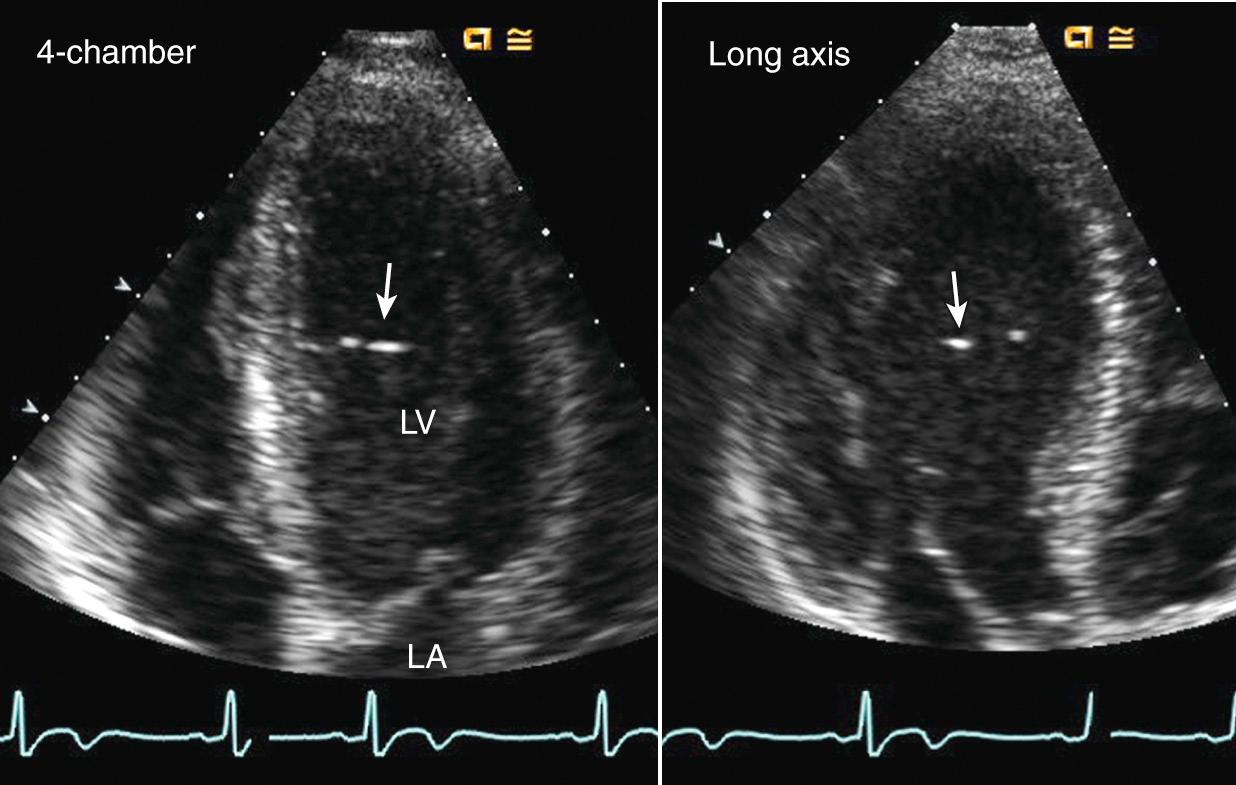
Valve anatomy includes a wide range of normal variation, and the appearance of a normal (but often unrecognized) structure, such as a nodule of Arantius, on the aortic valve may be considered incorrectly to represent a cardiac mass. The belly of a valve leaflet, if cut tangentially, may appear as a “mass” when it actually is a portion of the leaflet itself seen en face. In the atrium, normal ridges adjacent to the venous entry sites ( Figs. 15.2 and 15.3 ), normal trabeculations ( Fig. 15.4 ), postoperative changes (see Fig. 9.31 ), and distortion of the free wall contour by structures adjacent to the atrium ( Fig. 15.5 ) all may be diagnosed erroneously as a cardiac mass.
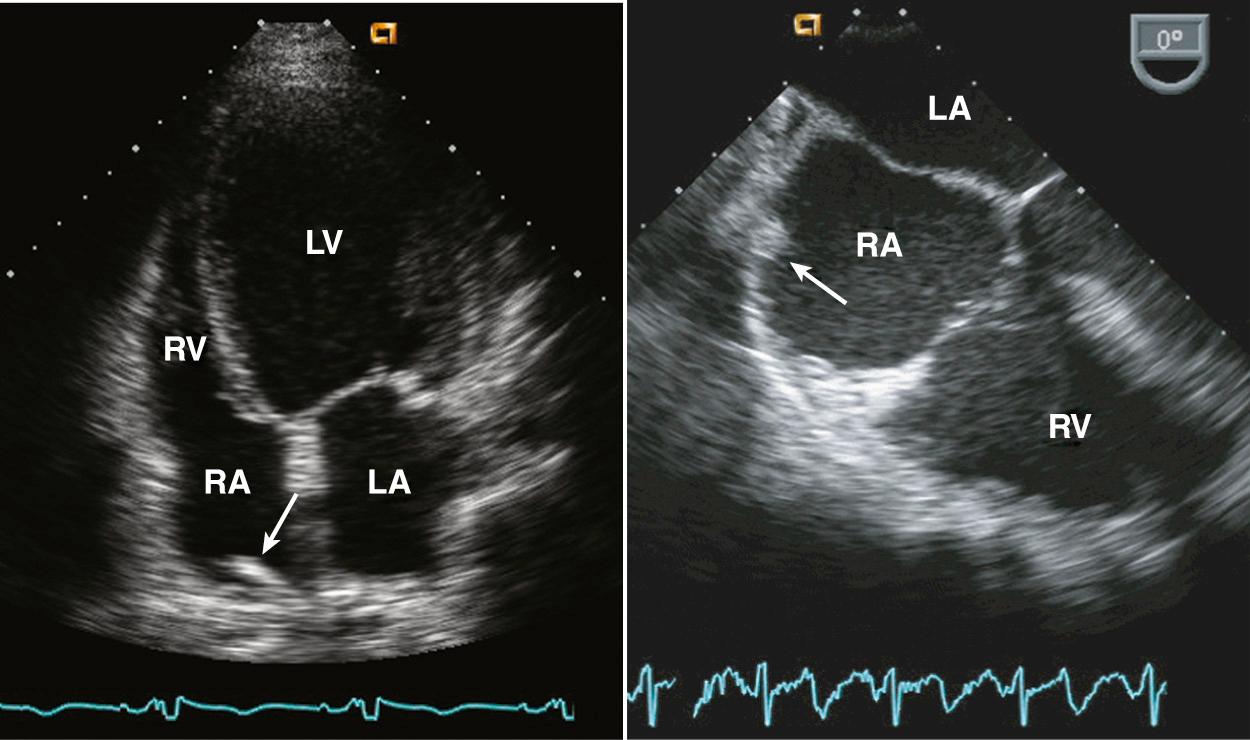
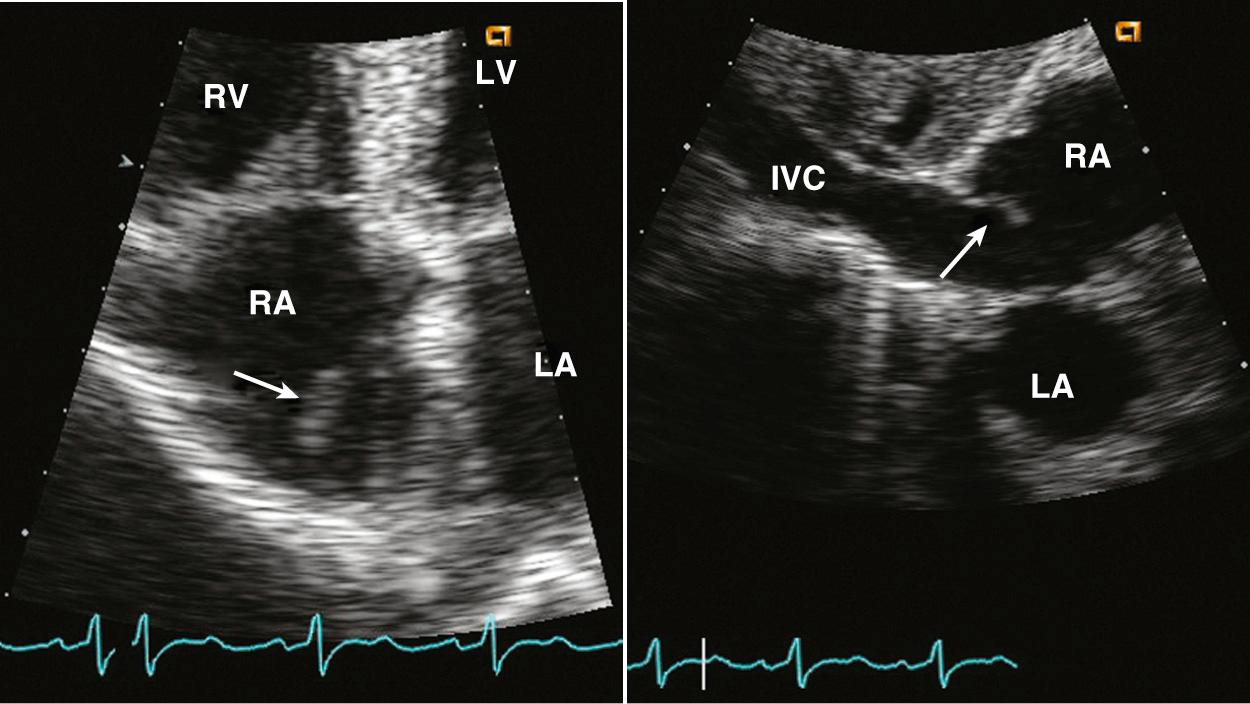
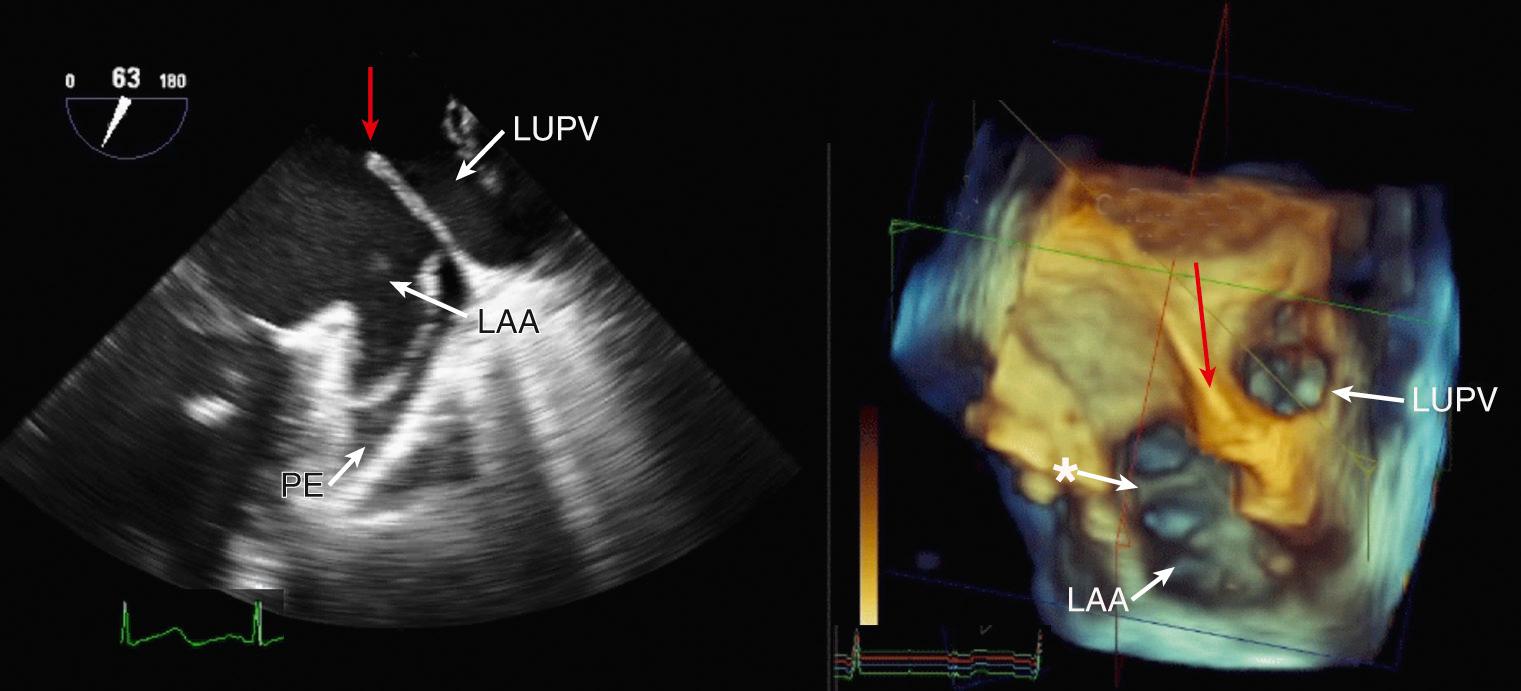
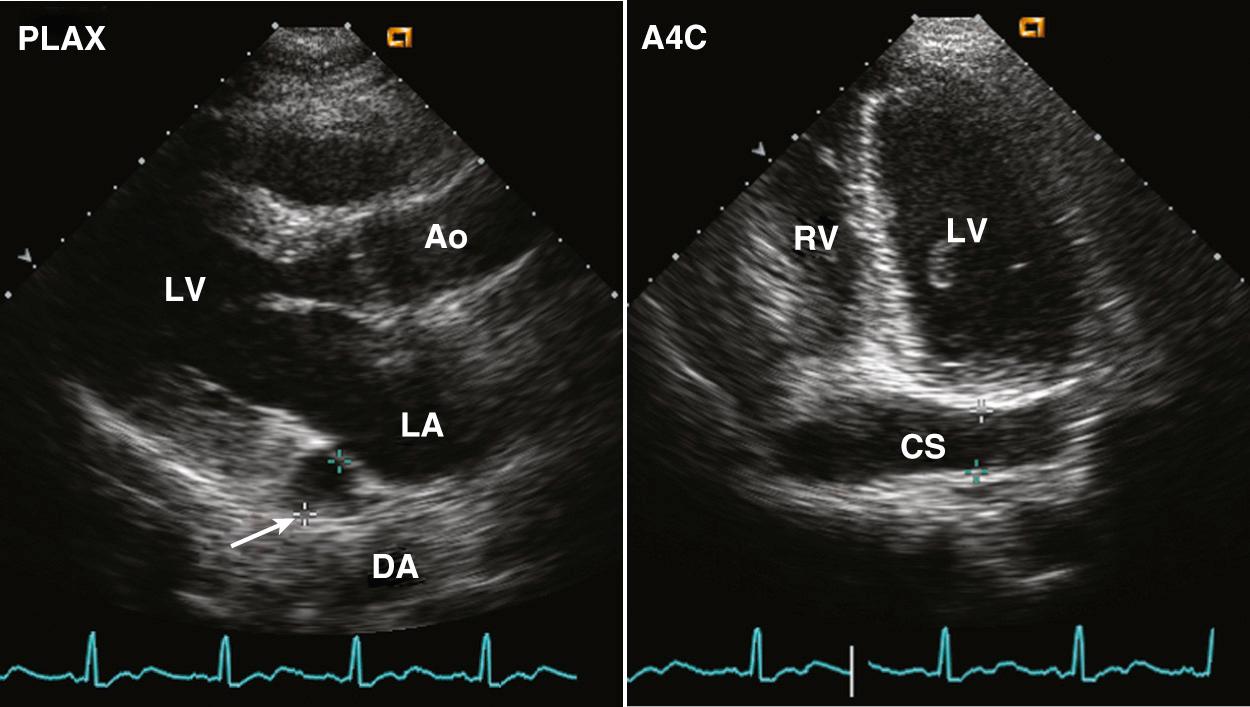
Definitive diagnosis of an intracardiac mass by echocardiography is based on:
Excellent image quality, which requires the use of a high-frequency (5- or 7.5-MHz), short-focus transducer to evaluate the LV apex from the transthoracic (TTE) approach and the use of transesophageal (TEE) imaging to evaluate posterior cardiac structures (e.g., LA, mitral valve). Three-dimensional (3D) echocardiography often provides better definition of the location and geometry of the mass.
Identification of the mass throughout the cardiac cycle, in the same anatomic region of the heart, from more than one acoustic window. This decreases the likelihood of an ultrasound artifact.
Knowledge of the normal structures, normal variants, and postoperative changes that appear similar to a cardiac mass.
Integration of other echocardiographic findings (e.g., rheumatic mitral stenosis and LA enlargement in a patient with suspected LA thrombus) and clinical data in the final echocardiographic interpretation.
Once it is clear that a cardiac mass is present, the next step is to determine whether that mass most likely is a tumor, a vegetation, or a thrombus. A definitive diagnosis generally cannot be made from the echocardiographic images alone because the microscopic and bacteriologic characteristics of the structure cannot be determined. However, a reasonably secure diagnosis often can be made by integrating the clinical data, echocardiographic appearance, and associated echo Doppler findings.
Infectious cardiac masses include valvular vegetations, which are seen in patients with endocarditis (bacterial or fungal). Noninfectious vegetations also occur in patients with nonbacterial thrombotic endocarditis (NBTE, or marantic endocarditis). Vegetations typically are irregularly shaped, attached to the upstream side of the valve leaflet (e.g., LA side of the mitral valve, LV side of the aortic valve), and exhibit chaotic motion that differs from that of the leaflets themselves ( Fig. 15.6 ). Valvular regurgitation is a frequent but not invariable accompaniment of endocarditis. Valvular stenosis due to the vegetation is rare. Paravalvular abscess, which also manifests as a cardiac mass, often is difficult to recognize on transthoracic imaging but can be diagnosed with high sensitivity and specificity on TEE echocardiography. Infectious cardiac masses are discussed in detail in Chapter 14 .
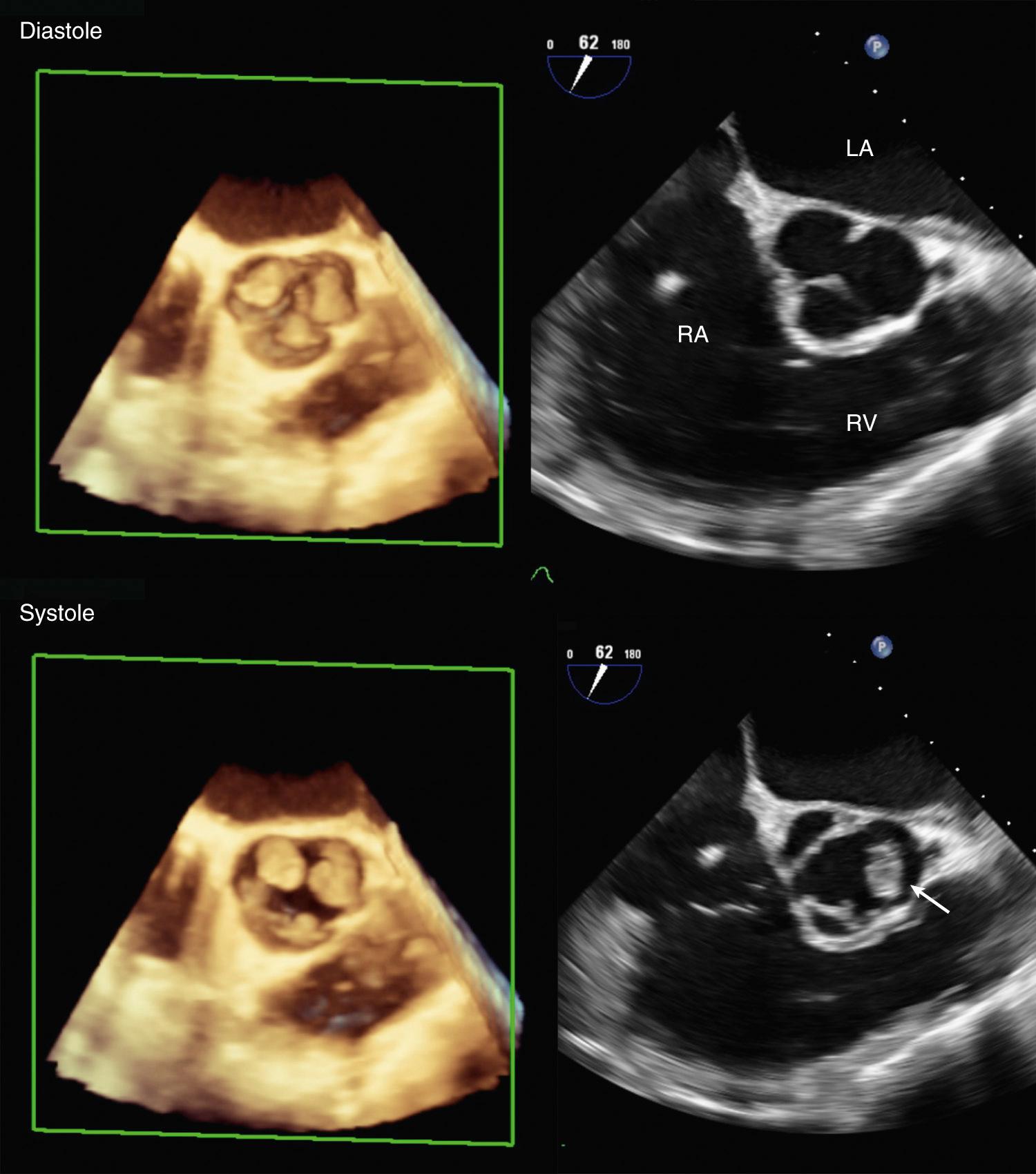
Nonprimary cardiac tumors are approximately 20 times more common than primary cardiac tumors. Tumors can involve the heart by direct invasion from adjacent malignancies (lung, breast), by lymphatic spread, or by metastatic spread of distant disease (lymphoma, melanoma) ( Fig. 15.7 ). In an autopsy series of patients with a malignant disease, cardiac involvement was present in approximately 10% of cases, although clinical recognition of cardiac involvement occurs less frequently. Melanoma has the highest rate of pericardial metastases, but because relatively few patients have melanoma, a cardiac tumor is more likely to represent a more prevalent malignant disease, as shown in Table 15.2 .
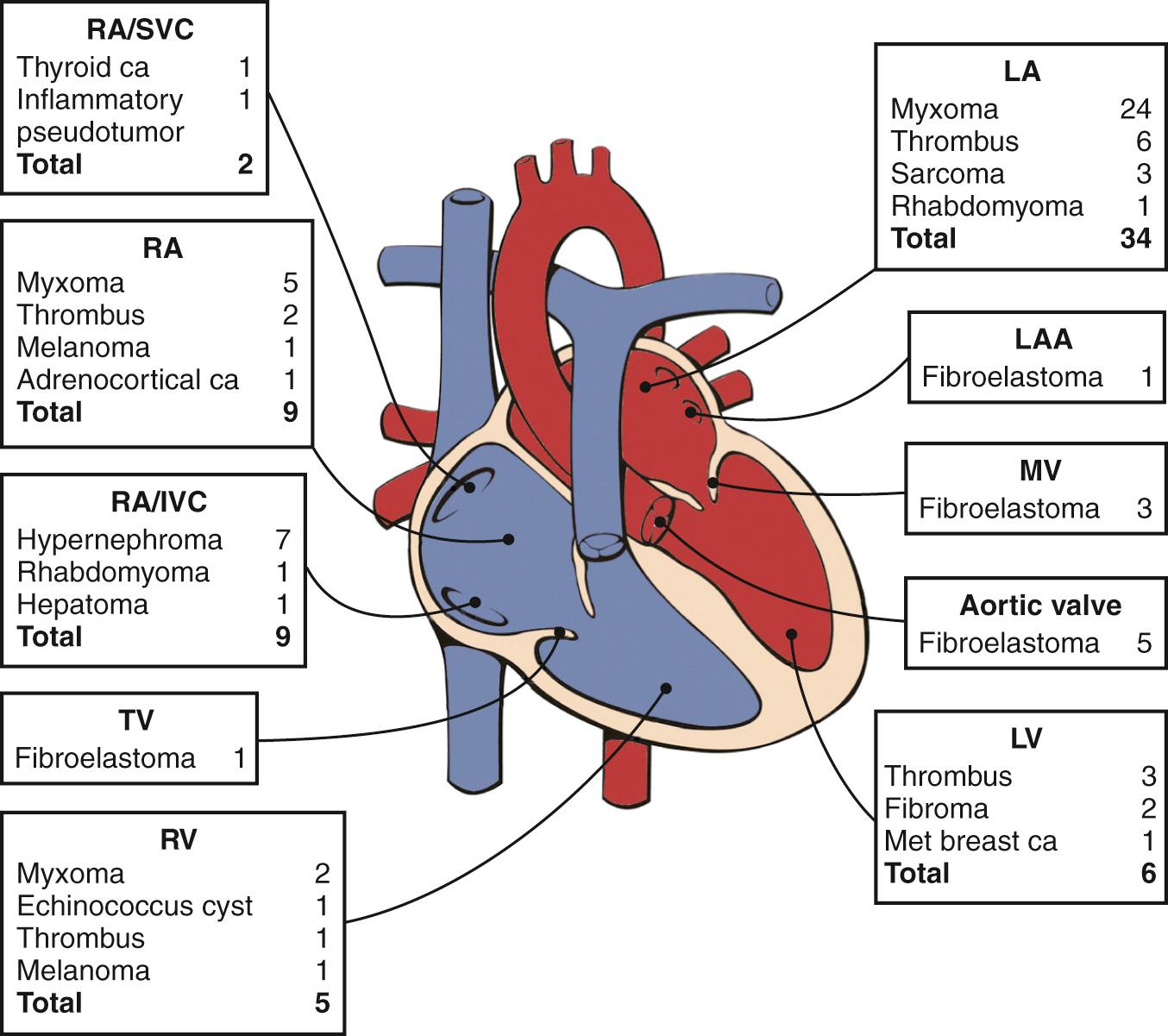
| Lung |
| Lymphoma |
| Breast |
| Leukemia |
| Stomach |
| Melanoma |
| Liver |
| Colon |
Almost three fourths of cardiac metastases are due to lung, breast, or hematologic malignancies. Lymphomas associated with acquired immunodeficiency syndrome (AIDS) have frequent and extensive cardiac involvement.
Nonprimary cardiac tumors can affect the heart by:
Invasion of the pericardium, epicardium, myocardium, or endocardium
Production of biologically active substances
Toxic effects of treatment on the heart (e.g., radiation or chemotherapy)
Cardiac malignancies most often involve the pericardium and epicardium (approximately 75% of metastatic cardiac disease) and manifest as a pericardial effusion, with or without tamponade physiology ( Fig. 15.8 ). Because echocardiographic diagnosis of the cause of a pericardial effusion rarely is possible, the diagnosis of a pericardial effusion (and particularly tamponade) in a patient with a known malignancy should alert the clinician to the possibility of cardiac involvement. Confirmation of the diagnosis requires examination of pericardial fluid and, if necessary, pericardial biopsy. The differential diagnosis of a pericardial effusion in a patient with a known malignancy includes radiation pericarditis and idiopathic pericarditis (which is common in patients with cancer), in addition to metastatic disease. Repeat echocardiographic evaluation of patients with a malignant pericardial effusion often is needed after the initial diagnosis for assessment of therapeutic interventions and follow-up for recurrent effusion.
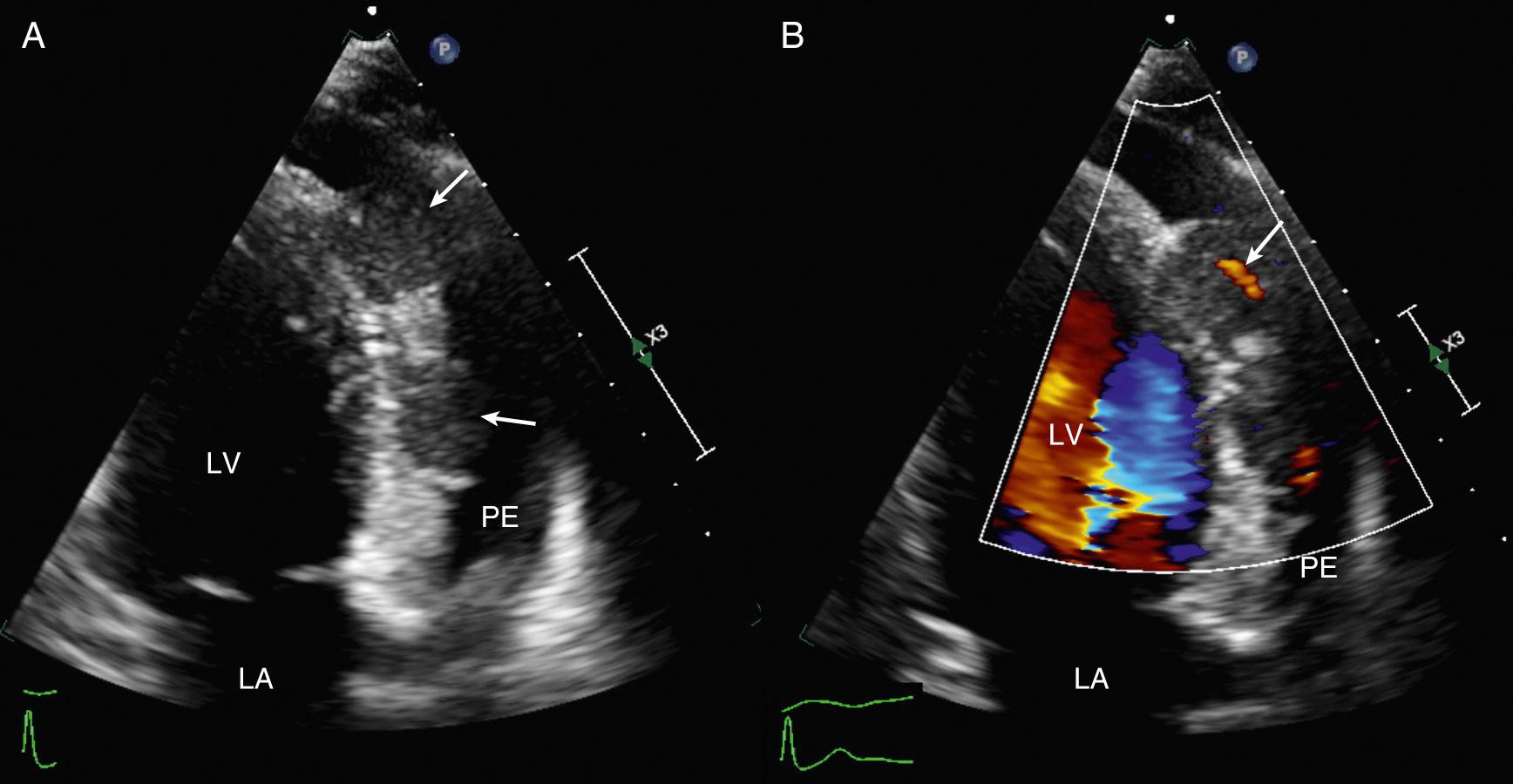
Myocardial involvement by metastatic disease is less common than pericardial involvement, but it does occur, particularly with lymphoma or melanoma. Intramyocardial masses can project into or compress cardiac chambers, with resulting hemodynamic compromise. Endocardial involvement is rarely seen.
A specific type of cardiac involvement by tumor that should be recognized by the echocardiographer is the extension of renal cell carcinoma up the inferior vena cava ( Fig. 15.9 ). A “fingerlike” projection of a tumor protrudes into the right atrium (RA) from the inferior vena cava, and the tumor can be followed retrograde (from a subcostal approach) back to the kidney. Correlation with other wide-view imaging techniques is needed for full delineation of the tumor extent. Uterine tumors also occasionally manifest in this fashion.
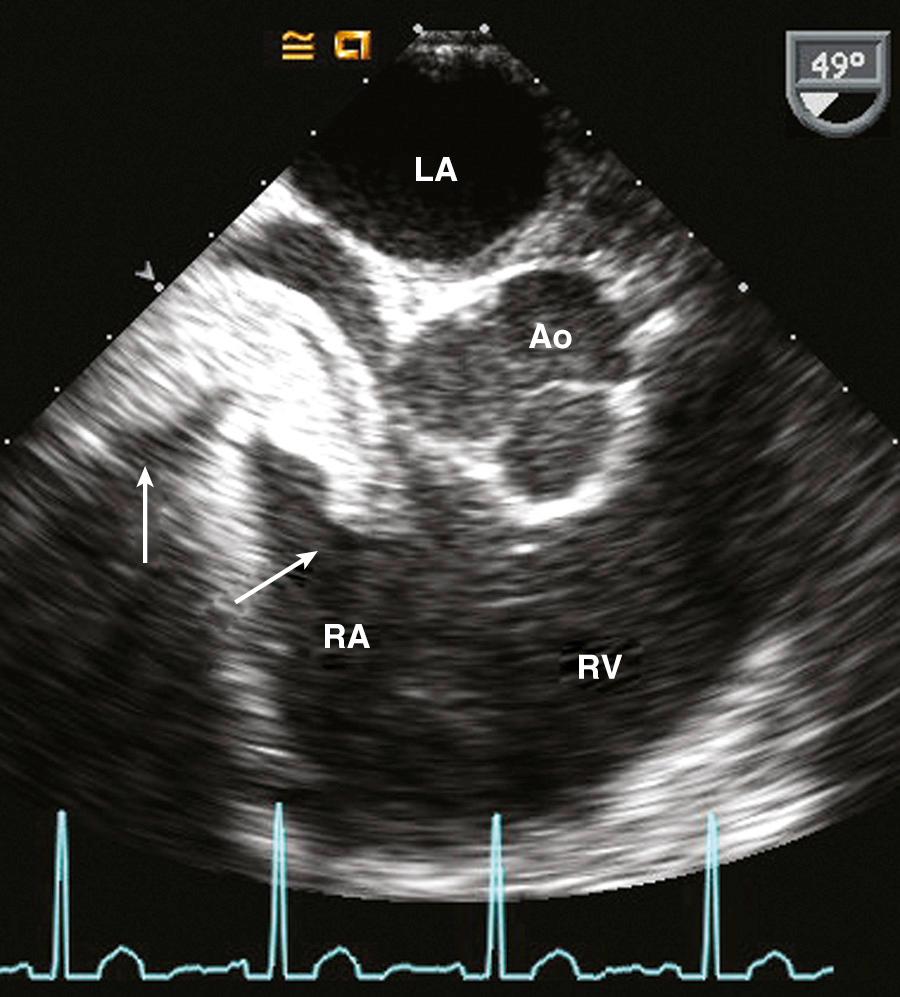
Tumors also can affect the cardiac structures indirectly, as is seen in carcinoid heart disease ( Fig. 15.10 ). Metastatic carcinoid tissue in the liver produces biologically active substances, including serotonin, which cause abnormalities of the right-sided cardiac valves and endocardium. Typical changes include thickening, retraction, and increased rigidity of the tricuspid and pulmonic valve leaflets, thus resulting in valvular regurgitation or, less often, valvular stenosis. Left-sided valvular involvement is rarely seen, possibly because of a lower concentration of the active molecules after passage through the lungs. Although metastatic carcinoid disease is rare, the echocardiographic findings are pathognomonic and should lead to the diagnosis in a patient in whom it was not considered previously. About one third of patients with carcinoid tumors have cardiac involvement, and one half of the deaths in patients with carcinoid disease are due to heart failure resulting from severe tricuspid regurgitation.
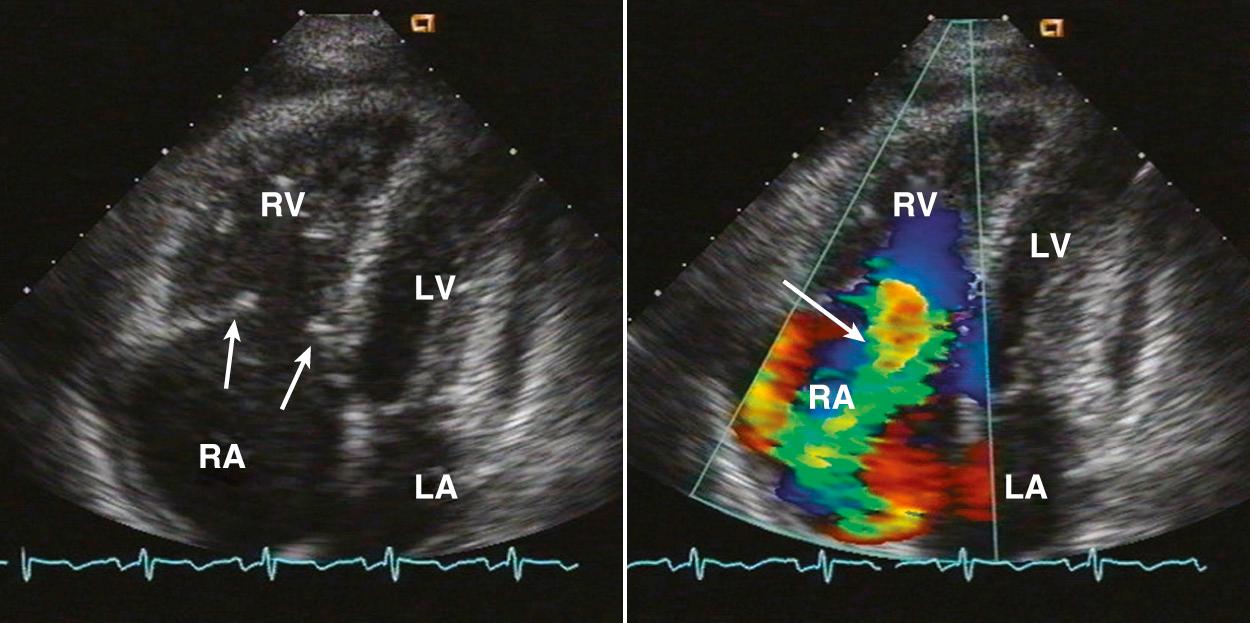
As for tumors elsewhere in the body, the distinction between benign and malignant primary cardiac tumors is based on pathologic examination of tissue and its tendency to invade adjacent tissue or metastasize to distant sites ( Table 15.3 ). Although 75% of primary cardiac tumors are benign, a pathologically benign cardiac tumor can have “malignant” hemodynamic consequences if it obstructs the normal pattern of blood flow. Thus, the echocardiographic examination includes definition of both the anatomic extent of a cardiac tumor and its physiologic consequences.
| Benign | |
| Myxoma | 27% |
| Lipoma | 10% |
| Papillary fibroelastoma | 10% |
| Hemangioma | 3% |
| Mesothelioma of the AV node | 1% |
| Malignant | |
| Angiosarcoma | 9% |
| Rhabdomyosarcoma | 5% |
| Mesothelioma | 4% |
| Fibrosarcoma | 3% |
| Malignant lymphoma | 2% |
| Extraskeletal osteosarcoma | 1% |
| Cysts | |
| Pericardial | 18% |
| Bronchogenic | 2% |
Myxomas account for 27% of primary cardiac tumors. Cardiac myxomas most often are single, arising from the fossa ovalis of the interatrial septum and protruding into the LA (in approximately 75% of cases) ( Fig. 15.11 ). Other sites of origin include the RA (18%), the LV (4%), and the right ventricle (RV) (4%). More than one site can occur in an individual patient (5% of cases).
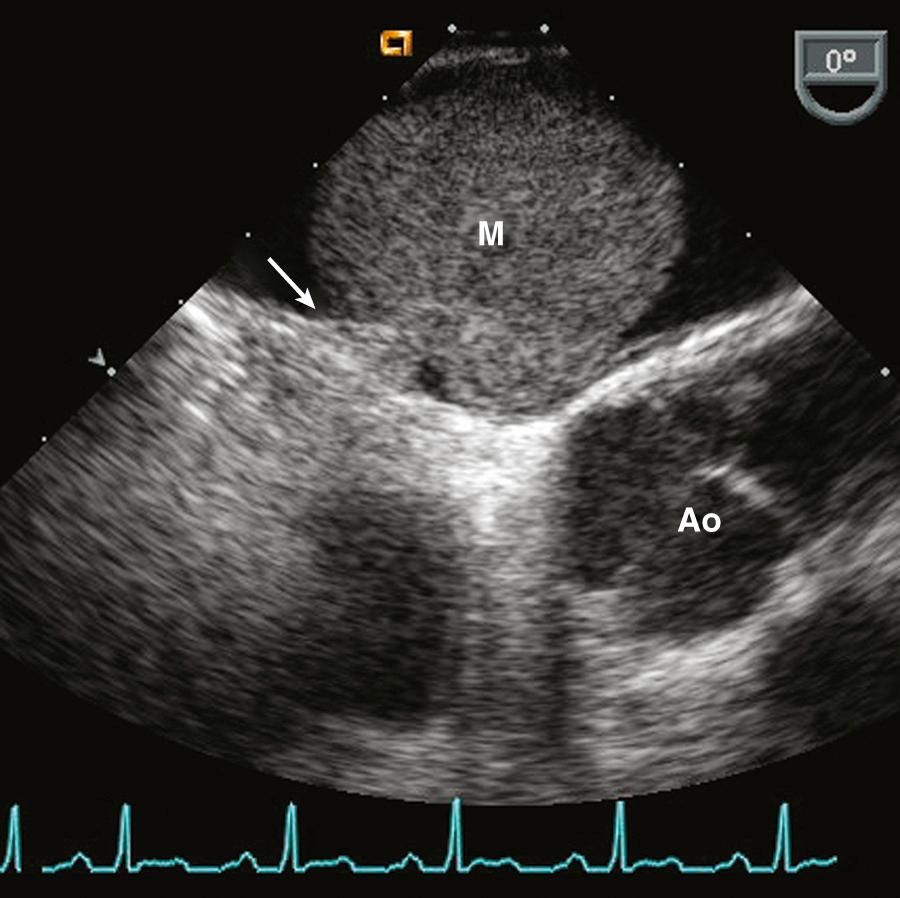
The clinical presentation of a cardiac myxoma includes constitutional symptoms (fever, malaise), clinically evident embolic events, and symptoms of mitral valve obstruction. A myxoma also may be an unexpected finding on a study requested for other clinical indications.
An LA myxoma varies in size from very small to nearly completely filling the LA chamber ( Fig. 15.12 ), with prolapse of the tumor mass across the mitral annulus into the LV in diastole (accounting for the tumor “plop” on auscultation). The mass often has an irregular shape characterized by protruding “fronds” of tissue or a “grape cluster” appearance. The echogenicity of the mass typically is nonhomogeneous, sometimes with areas of calcification.
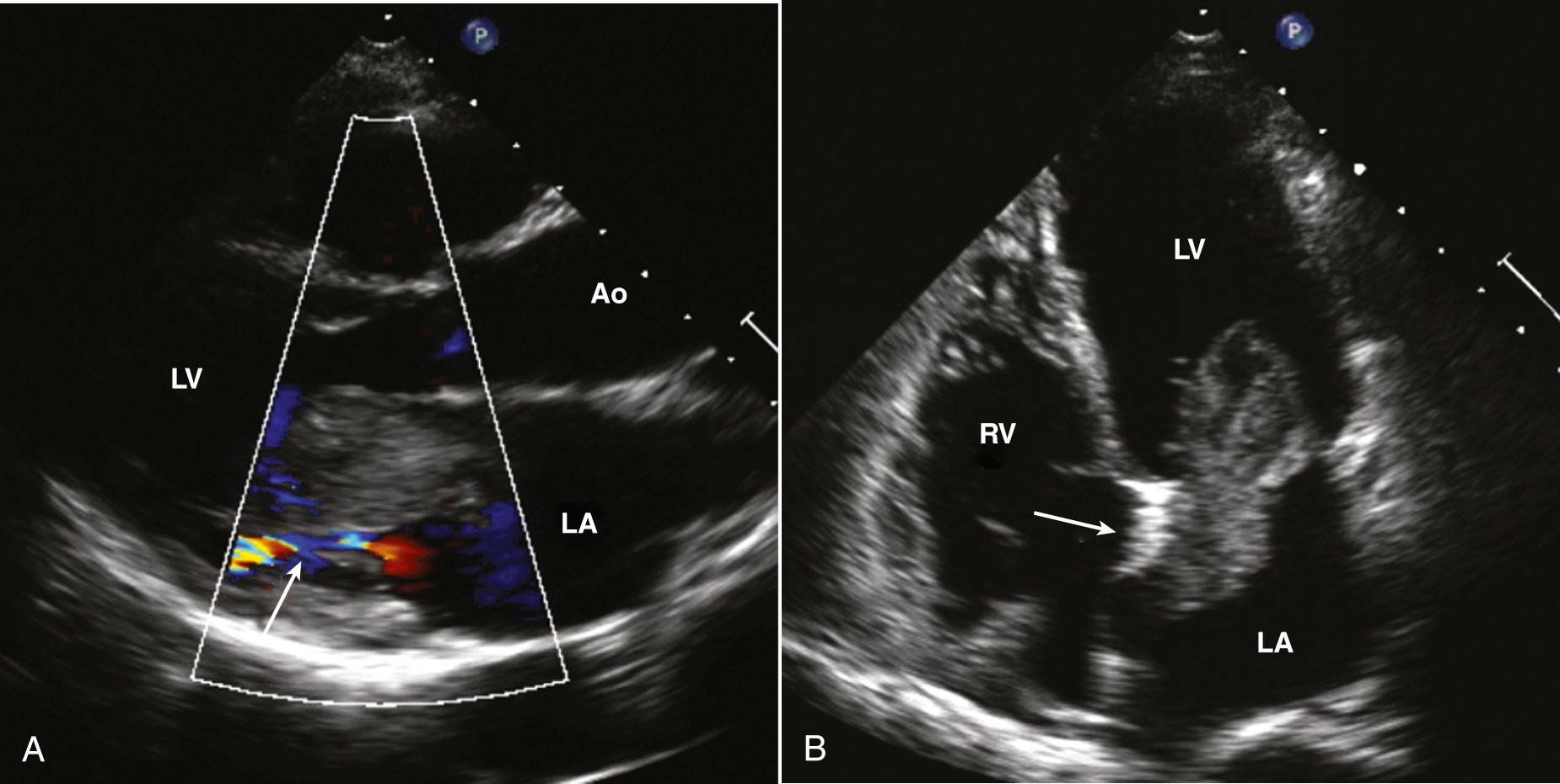
The degree to which the tumor causes functional obstruction to LV diastolic filling is evaluated qualitatively by color flow imaging and quantitatively by the pressure half-time method. Careful echocardiographic evaluation from multiple views, often including TEE, is needed in planning the surgical approach. Important goals of the echo examination are:
To identify the site of tumor attachment
To ensure that the tumor does not involve the valve leaflets themselves
To exclude the possibility of multiple masses
Postoperatively, complete excision should be documented by echocardiography. Sequential long-term follow-up is indicated because recurrent myxomas have been reported, particularly with a familial form of this disease, with multiple myxomas, or with a less than full-thickness excision.
The echocardiographic approach to myxomas arising in other locations is similar to that described for LA myxomas, except that the imaging and Doppler examination are tailored to evaluating the specific region of tumor involvement in that patient. Again, a diagnosis based on clinical features, anatomic location, and echocardiographic appearance is only presumptive until confirmed histologically. A “typical” myxoma may turn out to be a metastatic malignancy or a primary cardiac malignancy on pathologic examination. Hence the echocardiographic examination should be as complete as possible to exclude tissue invasion by the tumor, multiple sites of involvement, or atypical features.
A papillary fibroelastoma is a benign cardiac tumor that arises on valvular tissue, thus mimicking the appearance of a valvular vegetation. A papillary fibroelastoma appears as a small mass attached to the aortic or mitral valve with motion independent from the normal valve structures ( Fig. 15.13 ). Other attachment sites for a papillary fibroelastoma include the tricuspid or pulmonic valve and nonvalvular sites. Unlike a vegetation, a fibroelastoma is more often found on the downstream side of the valve (LV side of mitral valve, aortic side of aortic valve). The histologic appearance is very similar to that of the smaller Lambl excrescences, which can be seen on normal valves in older adults. Usually a small papillary fibroelastoma is of no clinical significance; the relationship of larger benign valve tumors to embolic events is controversial. In addition, some cases of superimposed thrombus formation resulting in systemic embolic events have been described. Often these tumors are better visualized on TEE imaging.
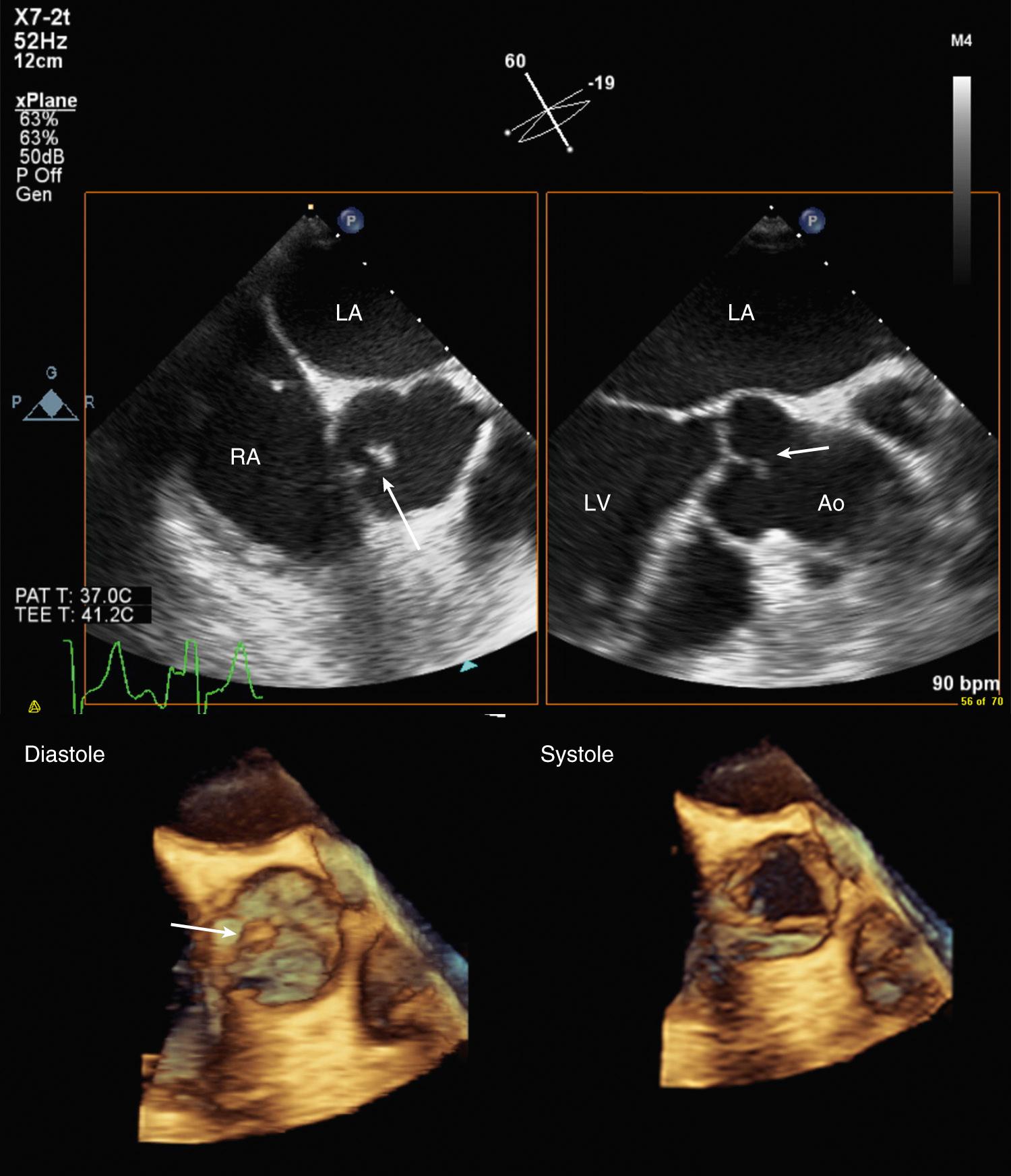
Other benign cardiac tumors seen in adults include hemangiomas and mesotheliomas of the atrioventricular node.
Lipomatous hypertrophy of the interatrial septum manifests as a cardiac mass that is often mistaken for a tumor. Lipomatous hypertrophy typically involves the superior and inferior fatty portions of the atrial septum and spares the fossa ovalis region ( Fig. 15.14 ). However, symmetric ellipsoid enlargements of the interatrial septum also have been described. If the cause of atrial septal hypertrophy is unclear on echocardiography, CT scanning establishes the diagnosis of lipomatous hypertrophy by showing the characteristic radiographic density of adipose tissue.
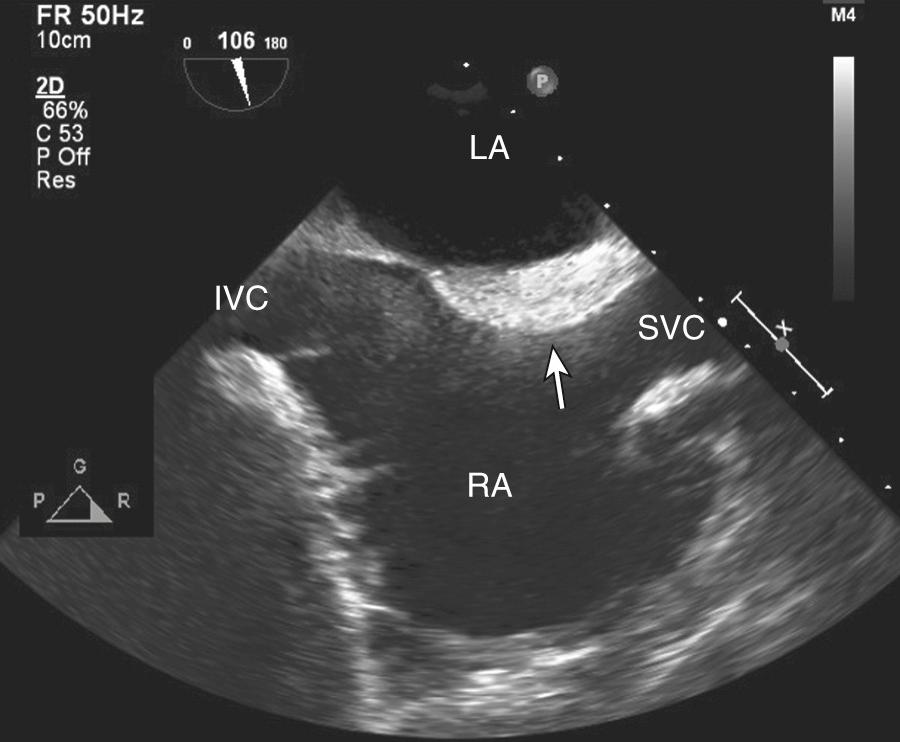
Malignant primary cardiac tumors are rare. In adults, angiosarcomas ( Fig. 15.15 ), rhabdomyosarcomas ( Fig. 15.16 ), mesotheliomas, and fibrosarcomas are seen (see Table 15.1 ). The clinical presentation is variable, ranging from an “incidental” finding on echocardiography or nonspecific systemic symptoms (fever, malaise, fatigue) to signs and symptoms of cardiac tamponade. Because metastatic disease is far more likely than a primary cardiac origin, thorough evaluation must include a search for potential primary sites. Ultimately, the diagnosis depends on examination of tissue from the cardiac mass.
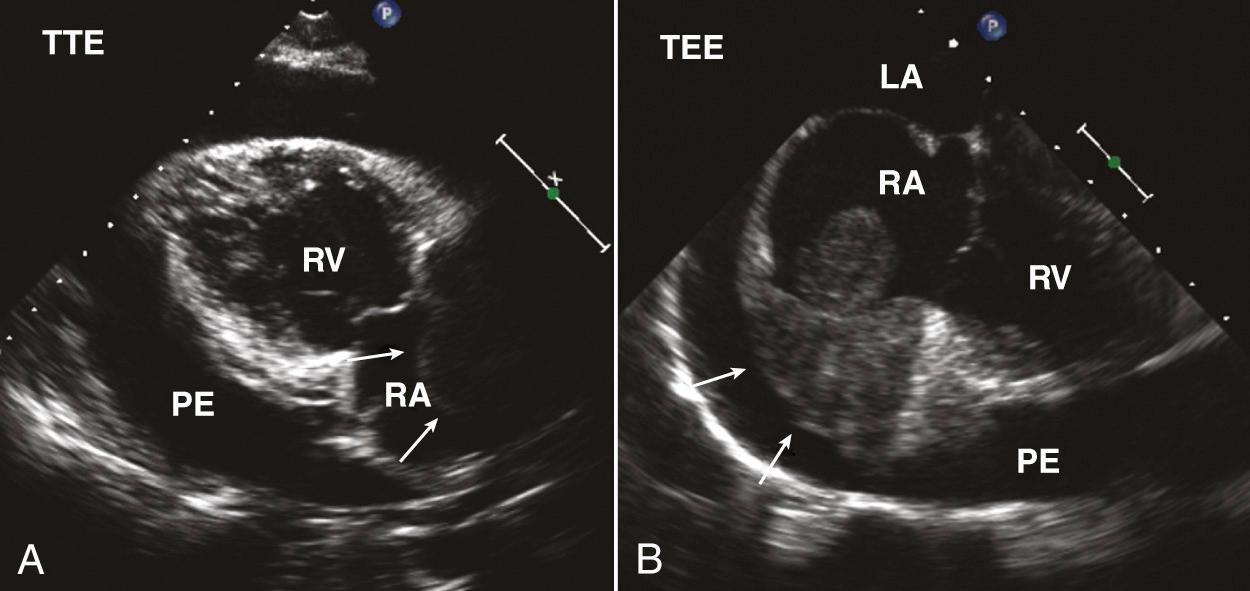
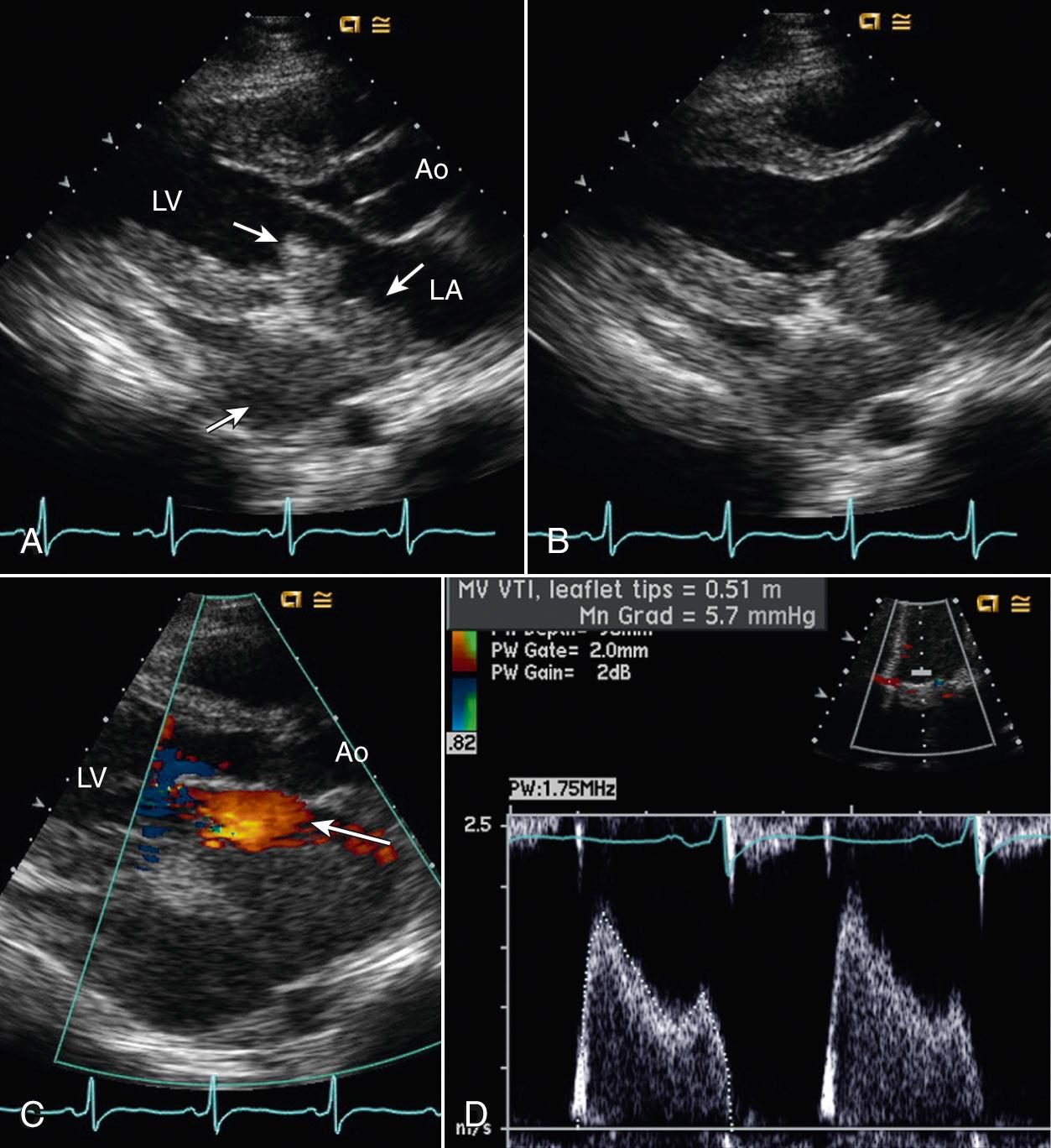
The echocardiographic examination focuses on:
The anatomic location and extent of the tumor involvement
The physiologic consequences of the tumor (e.g., valvular regurgitation, chamber obliteration, obstruction) (see Fig. 15.16 )
Associated findings (pericardial effusion, evidence of tamponade physiology)
Along with other imaging techniques, the echocardiographic examination helps guide therapy by determining whether the tumor is resectable or whether palliative cardiac procedures are likely to be beneficial. Specific attention also is directed toward possible involvement of the valves, coronary arteries, or conduction system.
Although echocardiography has definite advantages for evaluating cardiac tumors, it has significant disadvantages as well. These include (1) poor acoustic access, resulting in suboptimal image quality, which limits the confidence with which tumor location and extent can be defined or results in a missed diagnosis (TEE imaging obviates this limitation in some patients); (2) the need for a careful and meticulous examination to detect and evaluate fully the cardiac tumor (as for other applications, echocardiography is operator dependent, and a significant learning curve for obtaining optimal data can be observed); and (3) the limited “field of view” inherent in echocardiography (i.e., structures adjacent to the heart in the mediastinum and lung are difficult to evaluate). Other tomographic imaging techniques, specifically CT and CMR, have the advantage of a wide field of view, so the relationship between cardiac and extracardiac tumor involvement can be evaluated. Often judicious use of both echocardiographic techniques (to assess cardiac involvement in detail and to evaluate the physiologic consequences of the tumor mass) and CT or CMR (to assess potential extracardiac involvement) is needed in an individual patient for optimal clinical decision making. CT and CMR provide data on the tissue characteristics of the abnormal mass, which currently cannot be obtained with echocardiography ( Fig. 15.17 ).
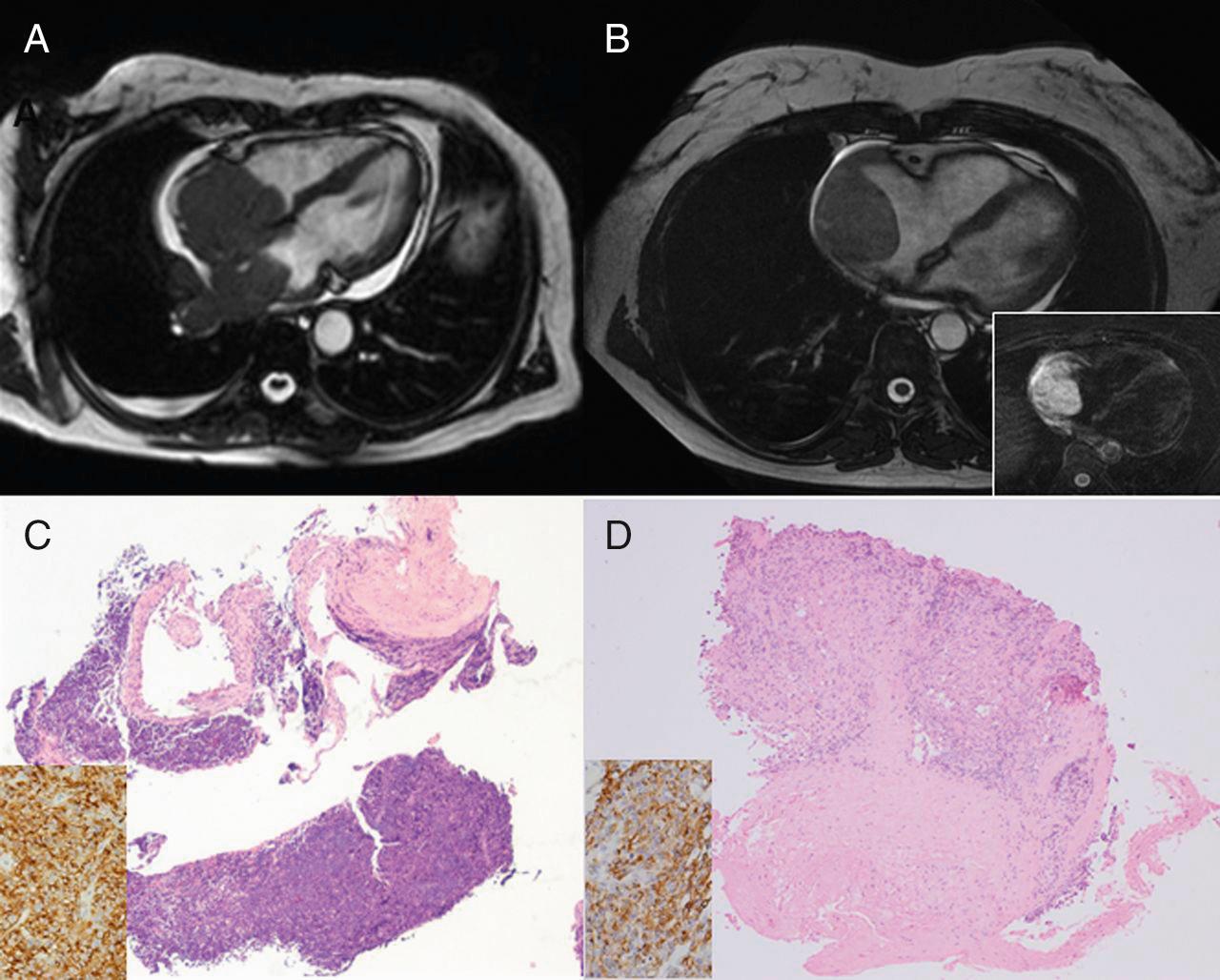
Become a Clinical Tree membership for Full access and enjoy Unlimited articles
If you are a member. Log in here